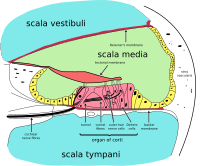
Photo from wikipedia
Otosclerosis is often called the disease inwhich the patient hears nothing and the physician sees nothing. This alludes to the often significant degree of hearing loss experienced by the patient… Click to show full abstract
Otosclerosis is often called the disease inwhich the patient hears nothing and the physician sees nothing. This alludes to the often significant degree of hearing loss experienced by the patient and the regular lack of visible physical findings in this disorder. Stapedotomy or stapedectomy surgery is likewise referred to as the easiest but most complicated surgery performed by otolaryngologists. In this circumstance, every step must be perfect, and everymovementmust be deliberate. There is a very short distance between a perfectly closed air-bone gap and a profound sensorineural hearing loss. Nevertheless, there is no better feeling as an otolaryngologist when the prosthesis enters the opening in the oval window and the patient reports, “I can hear!” Or when the patient comes in for their postoperative visit complaining that the world around them is too loud. I had one patient who greeted me in the recovery room with a big smile and said, “It’s so quiet!” She meant that, not only was her hearing better, but her tinnitus was gone. I pointed out to her that no ear doctor ever wants to hear that it is quiet! Drs Eshraghi and Telischi have compiled a complete reference guide on otosclerosis. The story of this disease and interventions is told from history to pathology and molecular biology, to imaging and audiometric assessment, through the nuances of medical and surgical intervention. Pathophysiologically, it begins as otospongiosis, a softening of the bone at the fissula ante fenestram and/or fossula post fenestram. Sometimes this is visible on physical examination as a promontory blush, also known as Schwartze sign. Drs Penido and Vicente explain how this can be imaged with state-of-the-art modalities and treated, which may result in prevention of progression of hearing loss and may even result in less need for surgery in certain individuals. The anatomy of the middle ear is exquisitely complex. My residents have heard me raise a tympanomeatal flap and immediately exclaim a welcome to the most beautiful
Journal Title: Otolaryngologic clinics of North America
Year Published: 2018
Link to full text (if available)
Share on Social Media: Sign Up to like & get
recommendations!